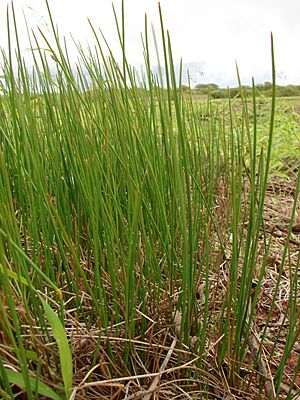Eleocharis facts for kids
Quick facts for kids Eleocharis |
|
|---|---|
 |
|
| Eleocharis calva | |
| Scientific classification |
|
| Kingdom: | Plantae |
| Clade: | Tracheophytes |
| Clade: | Angiosperms |
| Clade: | Monocots |
| Clade: | Commelinids |
| Order: | Poales |
| Family: | Cyperaceae |
| Genus: | Eleocharis R.Br. |
| Synonyms | |
|
|
Eleocharis is a large group of over 250 different kinds of flowering plants. These plants belong to the sedge family, called Cyperaceae. You can find Eleocharis plants almost everywhere in the world! That's why they are called "cosmopolitan."
The name Eleocharis comes from ancient Greek words. Heleios means "marsh dweller," and charis means "grace." So, the name describes these graceful plants that live in wet places. People often call them spikerushes or spikesedges.
You can find many different Eleocharis species in places like the Amazon Rainforest and the South American Andes mountains. They also grow in northern Australia, eastern North America, California, Southern Africa, and parts of subtropical Asia. Most Eleocharis plants live in wet areas, from sea level up to very high mountains.
Contents
What Makes Eleocharis Special?
All Eleocharis plants are easy to spot because of a few key features. Their stems are green and can make their own food using sunlight, just like leaves. However, they don't have regular green leaves. Instead, their leaves are tiny sheaths that wrap around the bottom of their stems.
How They Grow
Many Eleocharis species are strong plants that spread out using underground stems called rhizomes. These are common in tropical wetlands. Other species are small, clumpy plants that grow near streams. Some Eleocharis plants live completely underwater. These underwater plants often have special ways to make food, like being able to switch how they use carbon depending on their environment.
Their Flowers
All Eleocharis plants have their flowers at the very top of their stems. These flowers grow in a single, unbranched spikelet. Even though there are many different kinds of Eleocharis, it can be hard to tell them apart. Many species look very similar, even if they grow in different places.
A Famous Eleocharis Plant
One of the most well-known Eleocharis species is the Chinese water chestnut, called Eleocharis dulcis. This plant grows special underground parts called tubers on its rhizomes. These tubers are edible! You can peel them and eat them raw or cook them.
In Australia, a type of bird called the magpie goose loves to eat these tubers. They are a very important food source for the geese for a big part of the year.
Selected Species
Here are a few examples of Eleocharis species:
- Eleocharis acicularis – Also known as needle spikerush or dwarf hairgrass.
- Eleocharis dulcis – The famous Chinese water chestnut.
- Eleocharis palustris – Often called common spikerush.
- Eleocharis quadrangulata – Known as squarestem spikerush.
- Eleocharis rostellata – Called beaked spikerush.
See also
 In Spanish: Eleocharis para niños
In Spanish: Eleocharis para niños

